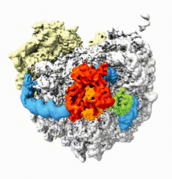Structural Biology
A molecular hammock for cotranslational modification
20.12.2018
Proteins do most of the real work in cells and are modified in accordance with functional requirements. Roland Beckmann and his team have now shown how proteins are chemically altered on the ribosome, even before they fold into the active conformations.

The functional properties of proteins – whether they serve as catalytic enzymes or play purely structural roles – are largely dictated by their three-dimensional shapes, which are in turn dependent on their amino-acid sequences and can be altered by chemical modification. The structural biologist Roland Beckmann studies the many essential tasks performed by proteins in cells, focusing in particular on those that take place during their synthesis. Protein synthesis is carried out by molecular machines known as ribosomes, which are themselves composed of proteins and ribosomal RNAs. These ‘organelles’ translate genetic blueprints encoded in ‘messenger RNAs’ into the specific sequences of amino acids that define the particular function of each type of protein in cells. Ribosomes work rather like assembly lines, connecting amino acids together in the sequence dictated by the mRNA to which they are bound.
Roland Beckmann and his research group at LMU’s Gene Center have now used cryo-electron microscopy to determine how certain enzymes interact with ribosomes to chemically modify nascent proteins. By imaging purified and flash-frozen ribosomal complexes in the electron microscope, they were able to reconstruct the modification process in three dimensions. The new findings have just been published in the journal Nature Structural and Molecular Biology.
For more information please visit LMU.de/news
Original Publication:
Ribosome-NatA architecture reveals that rRNA expansion segments coordinate N-terminal acetylation.
Knorr AG, Schmidt C, Tesina P, Berninghausen O, Becker T, Beatrix B, Beckmann R.
Nature Structural & Molecular Biology. 2018 Dec 17. doi: 10.1038/s41594-018-0165-y.

